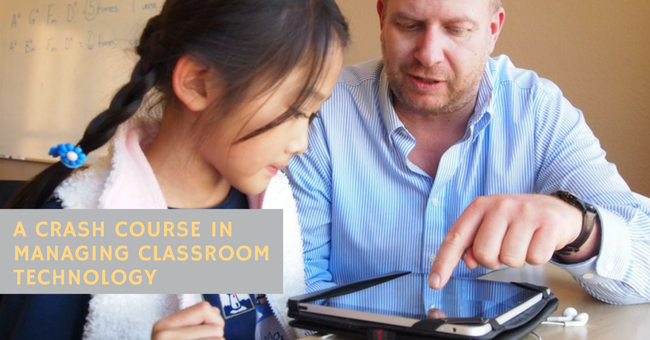
Today’s classrooms look nothing like they did 20 years ago. Notebooks are being replaced with laptops, chalkboards with smart boards, cursive with typing. Say what you will with the changing of the times, students today have the ability to participate much more actively in their education, and technology has a huge hand in making sure it happens smoothly, effectively, and measurably.
How well that classroom technology works depends on how it is designed, implemented, and supported. The actual classroom computers play a relatively small role in today’s modern educational environments; more important is how easy software is to find and use, which peripherals are connected, the strength and security of the network, and how well it is balanced with offline curriculum objectives.
In fact, when it comes to managing classroom technology, there are six questions you should consider.
- Will technology engage my students and make them active participants in learning?
It absolutely can. Technology, when used properly and when it works consistently, is an amazing classroom tool to support and engage students. However, simply having classroom computers or several available apps will not make every student learn and retain more or better information. The key is having the devices, peripherals, network, and support in place to make sure you have the right classroom technology for your age group, interests, and goals. Most importantly, remember that classroom computers are there to support the learning, not to drive it; they will never replace the most important element of the classroom--you, the teacher.
- Will the technology help me measure their individual progress so that I can better assess their needs and align them with their personal and classroom growth?
There are several apps and programs available that will both enhance your curriculum and provide you with supportive feedback to gauge your classroom learning and information retention. True retention and understanding are demonstrated in a student’s ability to put the information into practice and into their own words; technology helps support that process by allowing teachers measurable data on which to base individual and future instruction.
- How much technology am I comfortable with in the classroom? How much time do I need to reasonably allow for distribution, powering up and logging in, use, and powering down?
Much of this is a personal preference of the teacher and the actual learning environment. Classrooms with a 1:1 device ratio typically have a more streamlined approach to technology; everyone can start and stop a lesson plan at about the same time. Those classroom environments that share technology must rotate the use of their electronics as needed. The key is balancing the type of learning taking place and whether or not it helps you achieve your overall curriculum objectives. This takes time, discipline, awareness, and flexibility; the active use of these four components will help you discover the right mix of technology and traditional learning that works for your unique classroom needs.
- Which comes first: the lesson plan, or the technology used to support its instruction?
It’s our opinion that the offline lesson plans—and teachers—should always drive the classroom experience. Technology is an amazing away to support classroom objectives and, while there may be some instances where an application or program could inspire additional or new learning, the key should always be how best to engage students to be active participants in their own education, social awareness, and personal lives. Technology can support these goals in huge and impactful ways, especially when it is balanced with other "unplugged" directives.
- Which technology apps are best for me and my classroom?
You can imagine we get this question a lot at Arey Jones, and we answer it differently every time because no school, classroom, and teacher are the same. That said, educational applications and programs can help integrate awareness, practice, and retention throughout every step of the learning curve. We can help you discover which of these would be right for your district and classroom needs. - How do I minimize distractions?
The best way to ensure technology does not increase or create distractions is to use it purposefully. Your students should be aware of how the technology supports the specific lesson and what goals they are trying to achieve while using it. Providing the proper balance of online and offline time will help students stay focused and engage with the material in different formats, allowing for deeper learning and understanding.
We believe technology should always enhance a classroom, not distract from it. When you need an integrated technology architecture that works seamlessly with your classroom, school, and district goals, we at Arey Jones can help you design a solution that works.

